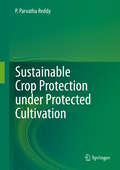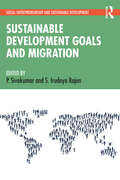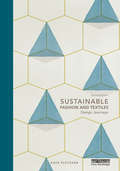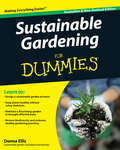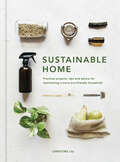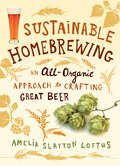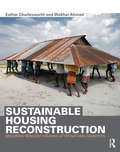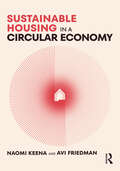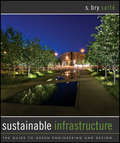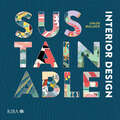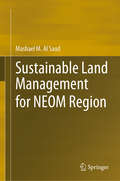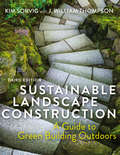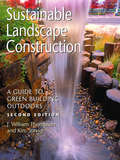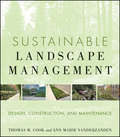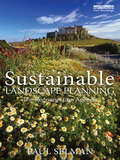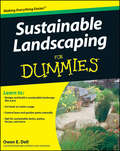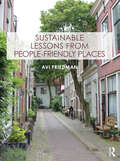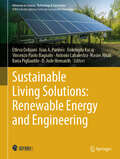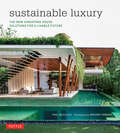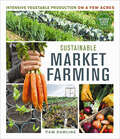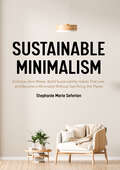- Table View
- List View
Sustainable Crop Protection under Protected Cultivation
by P. Parvatha ReddyThis book focuses on pests (insect and mite) and diseases (fungal, bacterial, viral and nematode) in protected horticulture (fruits, vegetables and ornamentals) using physical, cultural, chemical, biological, host resistance, and integrated methods. It opens with chapters describing the setting in which integrated pest and disease control operates, i. e. , the greenhouse and its environment. Subsequent chapters present the basic strategies and tactics of different control methods including integrated control, with special reference to greenhouse crops. Further chapters include the different facets of biological pest and disease control - its scientific bases, its development in practice, its commercialization and quality control. The concluding chapters of the book highlight the present status of integrated pest and disease control for the most important greenhouse crops (fruits, vegetables and flower crops) worldwide. The book's final chapter explores future challenges for researchers assigned to identify non-pesticide methods and integrate sustainable pest management technologies that can contribute to increased productivity, such as breeding for durable resistance, biological control and devising integrated methods that will have minimal adverse environmental and social impacts. Among productivity-enhancing technologies, protected cultivation has a tremendous potential to increase the yield of vegetables and flower cro ps by several fold. Pests and diseases are one of the major challenges to protected cultivation. Year-round warm temperatures and relatively high humidity together with abundant food make the protected environment of greenhouses highly attractive to pests and diseases. Nevertheless, very little attention has been paid to the manipulation of greenhouse environments expressly to avoid disease epidemics and insect infestations, which together can easily account for 30% of crop losses. This book will be of immense value to all members of the scientific community involved in teaching, research and extension activities on protected horticulture. It also offers a useful reference guide for policymakers and practicing farmers, and can be used as a textbook for postgraduate courses.
Sustainable Development Goals and Migration (Towards Sustainable Futures)
by P. Sivakumar S. Irudaya RajanThis book looks at migration in contemporary society and its interrelations with development. It presents the complexities and dilemmas associated with migration, the changes in theoretical and historical perspectives on migration and development, and the role of policies and the sustainable development goals in this context. The volume views migration as a phenomenon for advancing human development outcomes. It deals with wide-ranging issues including labour migration, the idea of decent work, migration and transnationalism, remittances, social networks and capital, and addressing poverty. The chapters highlight the focus of the Sustainable Development Goals (SDGs) and its relevance on migrant rights, safeguarding livelihoods and health. They also offer insights into regional and international co-operation on policies for migration, social growth and protection, and citizenship. With comparative analyses of data, trends and development indicators as well as various case studies, this volume examines the impact of migration on international relations and politics, labour market outcomes, gender, youth and education among others. It also discusses the loss of lives and livelihoods due to the Covid-19 pandemic, its impact on migration and the effects of the pandemic on the contemporary discussions on migration and SDGs. Rich in empirical data, this book will be an excellent read for scholars and researchers of migration and diaspora studies, development studies, refugee studies, public policy and governance, international relations, political studies, political economy, sociology and South Asian Studies.
Sustainable Fashion and Textiles: Design Journeys
by Kate FletcherFully revised and updated, the second edition of Sustainable Fashion and Textiles: Design Journeys continues to define the field of design in fashion and textiles. Arranged in two sections, the first four chapters represent key stages of the lifecycle: material cultivation/extraction, production, use and disposal. The remaining four chapters explore design approaches for altering the scale and nature of consumption, including service design, localism, speed and user involvement. While each chapter is complete in and of itself, their real value comes from what they represent together: innovative ways of thinking about textiles and garments based on sustainability values and an interconnected approach to design. Including a new preface, updated content and a new conclusion reflecting and critiquing developments in the field, as well as discussing future developments, the second edition promises to provide further impetus for future change, sealing Sustainable Fashion and Textiles: Design Journeys as the must-buy book for fashion and textiles professionals and students interested in sustainability.
Sustainable Gardening For Dummies (For Dummies Ser.)
by Donna EllisCreated especially for the Australian customer! Reduce your environmental footprint in the garden with this practical guide With all the talk about the health of the planet, you've probably heard about sustainability. Now you can apply these principles in your own backyard, whether that's an Aussie apartment balcony or a sprawling Kiwi rural spread. Find out great techniques for planning your sustainable garden and keeping your plants - and you - happy and healthy. Plant nutrients - what are they and how can you supply them to your plants sustainably? Watering techniques - how much water does your garden really need, and how can you conserve and supply it? Landscaping and gardening materials - where do they come from and are they sustainable? Biodiversity - how do you help increase the biodiversity of the planet through your own gardening practices? Organic gardening, permaculture and biodynamics - what methods can you adopt to improve your sustainable garden? Weeds and pests - how are they defined, and how do you control them while being kind to the environment? Compost heaps and worm farms - how do you build and maintain them, and what do they do for your garden? Potting mix - how can you choose a sustainable product or even make your own?
Sustainable Home: Practical Projects, Tips and Advice for Maintaining a More Eco-Friendly Household
by Christine LiuA stylish, inspirational, and practical guide to maintaining a more environmentally friendly household—includes eighteen projects both big and small.Sustainable lifestyle blogger and professional Christine Liu takes you on a tour through the rooms of your home—the living area, kitchen, bedroom, and bathroom—offering tips, tricks, and 18 step-by-step projects designed to help you lead a more low-impact lifestyle.From guidance on decluttering and living minimally to advice about plant-based foods to tips on repairing old clothes, this book touches every aspect of home life. Whether it’s by making your own toothpaste, converting to renewable energy sources, reducing your consumption of plastic, growing your own herb garden, or upcycling old pieces of furniture, the projects in this book offer numerous ways—both large and small—to make a difference.
Sustainable Homebrewing: An All-Organic Approach to Crafting Great Beer
by Amelia Slayton LoftusBrew delicious organic beer at home. In this comprehensive guide, Amelia Slayton Loftus covers everything you need to know to brew at home with organic ingredients, stressing practices that minimize waste and use sustainable resources. Along with 30 irresistible recipes, Loftus provides expert tips on buying equipment, harnessing solar energy, recycling water, using spent grain, and growing your own organic barley, hops, and herbs. You’ll enjoy brewing homemade beer that not only tastes great, but is good for the environment.
Sustainable Housing Reconstruction: Designing resilient housing after natural disasters
by Esther Charlesworth Iftekhar AhmedThrough 12 case studies from Australia, Bangladesh, Haiti, Sri Lanka, Vietnam and the USA, this book focuses on the housing reconstruction process after an earthquake, tsunami, cyclone, flood or fire. Design of post-disaster housing is not simply replacing the destroyed house but, as these case studies highlight, a means to not only build a safer house but also a more resilient community; not to simply return to the same condition as before the disaster, but an opportunity for building back better. The book explores two main themes: Housing reconstruction is most successful when involving the users in the design and construction process Housing reconstruction is most effective when it is integrated with community infrastructure, services and the means to create real livelihoods. The case studies included in this book highlight work completed by different agencies and built environment professionals in diverse disaster-affected contexts. With a global acceleration of natural disasters, often linked to accelerating climate change, there is a critical demand for robust housing solutions for vulnerable communities. This book provides professionals, policy makers and community stakeholders working in the international development and disaster risk management sectors, with an evidence-based exploration of how to add real value through the design process in housing reconstruction. Herein then, the knowledge we need to build, an approach to improve our processes, a window to understanding the complex domain of post-disaster housing reconstruction.
Sustainable Housing in a Circular Economy
by Avi Friedman Naomi KeenaThis book relates circular economy principles to housing design and construction and highlights how those principles can result in both monetary savings, positive environmental impact, and socio-ecological change.Chapters focus on three key circular economy principles and apply them to architectural construction and design, namely rethinking of the end-of-use phase of a building and the potential of design-for-disassembly; the role of digitization and data standardization in fostering evidence-based circular economy design decision-making; and presenting space as a resource to conserve, via exploration of the sharing economy and flexibility principles. Beyond waste management and material cycles, this book provides a holistic understanding of the opportunities across the building life cycle that can allow for sustainable and affordable circular housing. With case studies from 13 different countries, including but not limited to the Hammarby Sjöstad district in Sweden, the Circle House in Denmark, Benny Farm in Canada, VMD Prefabricated House in Mexico, and the Deep Performance Dwelling in China, authors pair theoretical frameworks with real-world examples.This will be a useful resource for upper-level students and academics of architecture, construction, and planning, especially those studying and researching housing design, building technology, green project management, and environmental design.
Sustainable Infrastructure
by S. Bry SarteAs more factors, perspectives, and metrics are incorporated into the planning and building process, the roles of engineers and designers are increasingly being fused together. Sustainable Infrastructure explores this trend with in-depth look at sustainable engineering practices in an urban design as it involves watershed master-planning, green building, optimizing water reuse, reclaiming urban spaces, green streets initiatives, and sustainable master-planning. This complete guide provides guidance on the role creative thinking and collaborative team-building play in meeting solutions needed to affect a sustainable transformation of the built environment.
Sustainable Infrastructure Investment: Toward a More Equitable Future
by Eric Christian BruunThis book provides examples and suggestions for readers to understand how public investment decisions for sustainable infrastructure are made. Through detailed analysis of public investment in infrastructure over the last few decades in the United States, the United Kingdom, and Finland, the author explores how the decision-making processes for major public works spending, many of them requiring quite rigorous and detailed computational methodologies, can result in plans that underserve large portions of the population, are inequitable, and fail to efficiently preserve public property. Beginning with some of the commonly offered explanations for the slow pace of investment and repair in a supposedly prosperous society facing serious environmental challenges, the book then explores media’s role in shaping the public-at-large’s understanding of the situation and the unimaginative solutions put forward by politicians. It continues with some case studies of infrastructure investment, or lack thereof, including an exploration of competing uses for government funds. It concludes with some suggestions. It is aimed at a large readership of professionals, students, and policy makers in political science, urban planning, and civil engineering.
Sustainable Interior Design
by Chloe BullockWhat does it mean to be a sustainable interior designer? Where do you start? This book demystifies how to be a sustainable interior designer, both within practice and on design projects. It gives you the tools to educate clients that sustainable practice isn’t necessarily more expensive, and what the options available to them are in terms of design concept, materials and finishes. Importantly, the book also looks at sustainable supply chains, particularly important when specifying FF+E. Where to start being sustainable can be a difficult decision. Acting as a primer for interior designers at any stage of their career, it outlines what you really need – and don’t need – to know. Inspirational case studies from around the world sit alongside crucial guidance on the benefits of being sustainable and how to work with enlightened clients. There is information on how sustainable design contributes to health and wellbeing, all backed up by authoritative best practice guidance.
Sustainable Land Management for NEOM Region
by Mashael M. Al SaudThis book is the first of its type on NEOM Region, NW of Saudi Arabia. This region has been designated in 2017 to be an international economic hub. However, no studies have been done on this region which occupies several natural resources including remarkable landscape with unique ecological species, ores and water resources. The region is also vulnerable to many aspects of threatening natural hazards.Based on her expertise, namely geomorphological processes, earth sciences, space techniques and natural risk assessment, the author made an initiative to produce this book using advanced tools, specifically satellite images and geo-information system. The book introduces several thematic maps obtained for the first time for NEOM Region. Hence, it represents a scientific guide for land management and urban planning approaches. This book is a very significant document for a variety of readers and researchers including decision makers, land managers and planners, as well as geographers and geologists. In addition, the basic concepts and new approaches attract researchers and academic teams including students, universities and research centers not only in Saudi Arabia, but in different parts of the World.
Sustainable Landscape Construction, Third Edition: A Guide to Green Building Outdoors
by J. William Thompson Kim SorvigSince the publication of the first edition in 2000, Sustainable Landscape Construction has helped to spur a movement towards resilient outdoor environments, in the U.S. and throughout the world. The third edition has been updated to include important recent developments in this landscape revolution. It remains essential reading for everyone with an interest in "green" design of outdoor spaces and infrastructures.Like its predecessors, the new edition of Sustainable Landscape Construction is organized around principles, recognizing that built environments, and our work in them, pose both pragmatic and ethical challenges. Each chapter focuses on one overarching site goal, such as "Pave Less,” "Heal Injured Sites,” and "Consider Origin and Fate of Materials.” These principles of land sustainability are clearly articulated and developed through specific examples of more than 100 projects from around the world, reflecting both traditions and recent innovations. Expanded coverage of industry trends toward performance monitoring, and of lessons from project failures, form an important enhancement in this edition. New content also details the necessity to plan adaptively, not just preventively, for the realities of changing climate and intensifying weather. Some of the trends covered will shift how landscape architects and contractors will do business in challenging years ahead: to survive, many professionals and clients will focus on restoration projects, motivated by ecosystem services and social justice, and funded by innovative methods.Sustainable Landscape Construction is part of the canon of landscape construction texts, and with this update, remains a visionary, one of a kind reference for professionals and students.
Sustainable Landscape Construction: A Guide to Green Building Outdoors, Second Edition
by J. William Thompson Kim SorvigPublished at the beginning of the twenty-first century, Sustainable Landscape Construction took a new approach to what was then a nearly new subject: how to construct outdoor environments based on principles of sustainability. This enormously influential book helped to spur a movement that has taken root around the U.S. and throughout the world. The second edition has been thoroughly updated to include the most important developments in this landscape revolution, along with the latest scientific research in the field. It has been expanded to provide even more ideas for designing, building, and maintaining environmentally sensitive landscapes. It is essential reading for everyone with an interest in "green" landscape design. Like its predecessor, the new edition of Sustainable Landscape Construction is organized around principles that reflect the authors' desire to put environmental ethics into practice. Each chapter focuses on one over-arching idea. These principles of sustainability are clearly articulated and are developed through specific examples. More than 100 projects from around the globe are described and illustrated. A new chapter details ways in which landscape architectural practice must respond to the dangers posed by fire, floods, drought, extreme storms, and climate change. Sustainable Landscape Construction is a crucial complement to basic landscape construction texts, and is a one-of-a-kind reference for professionals, students, and concerned citizens.
Sustainable Landscape Management: Design, Construction, And Maintenance
by Thomas W. Cook Ann Marie VanderzandenThe complete guide to the sustainable management of landscapesA must-have guide for anyone working with landscapes, Sustainable Landscape Management eases the transition of the landscape industry into a new era of green consciousness. Filled with examples that illustrate best practices, the book provides a practical framework for the development of sustainable management strategies from design to execution and, eventually, to maintenance in an effort to construct landscapes that function more efficiently and minimize the impact on the environment. Sustainable Landscape Management includes:An overview of sustainable design and construction techniques as the basis for the maintenance and management of constructed landscapesCoverage of ecosystem development, managing landscape beds, managing trees and shrubs, and lawn careAn entire chapter devoted to issues associated with the use of chemicals in landscape managementGuidance on retrofitting existing landscapes for sustainabilityReshaping the landscape takes on more significance as society embraces a new value system for advancing environmentally friendly ideals. By following the management principles laid out in this book, readers will learn the key elements for building landscapes that integrate beauty and function to create a sustainable presence that extends well into the future.
Sustainable Landscape Planning: The Reconnection Agenda
by Paul SelmanThis book takes as its starting point the need to examine critically the case for landscape reconnection. It looks at alleged disconnections and their supposed consequences. It explores the arguments about reconnecting the natural and human elements of whole landscapes. More broadly, it considers landscape as an arena within which science, humanities and professions can find common ground, and in which vivid social learning can occur about key social and environmental issues. It takes a dynamic view of landscape, in contrast to the popular image of timeless, traditional scenery. It accepts that even the most cherished cultural landscapes will change and, indeed, it views 'change drivers' as a potentially positive means of creating new connectivities between people and place. It recognises the growing interest in promoting resilience and ecosystem services across extensive landscapes - such as by creating new 'space' for water and wildlife.
Sustainable Landscaping For Dummies
by Owen E. DellSustainable Landscaping For Dummies provides hands-on, how-to instruction for realizing the benefits of a sustainable landscape, from selecting sutainable hardscape materials to installing a rain-water catchment system to choosing native plants.
Sustainable Lessons from People-Friendly Places
by Avi FriedmanCurrent planning and design modes of cities are facing challenges of philosophy and form. Past approaches no longer sustain new demands and call for innovative thinking. In a world that is becoming highly urbanized, the need for a new outlook is propelled by fundamental global changes that touch upon environmental, economic and social aspects.The book introduces fundamental principles of timely sustainable urban design, paying attention to architecture, integration of natural features, public urban spaces and their successful use. Readers will learn how cities are transitioning to active mobility by placing the wellbeing of citizens at the heart of planning; making buildings fit nature; supporting local culture through preservation; and including community gardens in neighborhoods, among others. Written by a practicing architect, professor and author, the book is richly illustrated and features meticulously selected international case studies.
Sustainable Lifestyles after Covid-19 (Routledge-SCORAI Studies in Sustainable Consumption)
by Lei Zhang Philip J. Vergragt Fabián Echegaray Valerie BrachyaThis book takes an in-depth look at Covid-19-generated societal trends and develops scenarios for possible future directions of urban lifestyles. Drawing on examples from Brazil, China, and Israel, and with a particular focus on cities, this book explores the short and long-term changes in individual consumers and citizen behavior as a result of the Covid-19 pandemic. On the basis of extensive market and opinion research data, aggregate data, observational evidence, and news reports, the authors provide a detailed account of the transformations that have occurred as a result of a triple shock of public health emergency, economic shutdown, and social isolation. They also examine which of these behavioral changes are likely to become permanent and consider whether this may ultimately promote or restrain sustainable lifestyle choices. Innovative and timely, this book will be of great interest to students, scholars, and professionals researching and working in the areas of sustainable consumption, urban and land use planning, and public health.
Sustainable Living Solutions: Renewable Energy and Engineering (Advances in Science, Technology & Innovation)
by Ivan A. Parinov D. Jude Hemanth Hasim Altan Ilaria Pigliautile Etleva Dobjani Vincenzo Paolo Bagnato Enkelejda Kucaj Antonio LabalestraThis book includes topics that explore diverse and innovative aspects of architectural design, urban planning, infrastructure, and engineering. The "Values Trilogy Design Philosophy" emphasizes the harmonious integration of sustainability, cost-effectiveness, and artistic expression in architectural projects. "DIGIT-ACCESS" explores a digital gateway to enhance accessibility to heritage architectures. The influence of biomimicry and biophilia on sustainable urban planning is examined, along with the application of biomimetic approaches in smart city design and traditional architecture in Saudi Arabia's Asir region. An analytical study investigates zero-energy concepts in high-rise buildings, while another contrasts the thermal performance of various insulation systems in hot-desert climates. The role of interior design in fostering creativity and cultural enrichment in performance arts academies is highlighted, alongside an architectural appraisal of user perceptions toward Tamil Nadu Housing Board (TNHB) low-income housing schemes. In the realm of electrical, mechanical engineering, and fabrication, this book covers advanced topics such as reducing peak average power ratio in OFDM systems for cognitive radio, nonlinear buckling analyses of corrugated steel plate shear walls, and accelerated corrosion testing of carbon steel. The mechanical characteristics of sustainable rigid pavement using sintered fly ash aggregate are explored, as well as the impact of fiberglass reinforced concrete on sustainable design. Additional studies include the evaluation of water resistance in glass-modified concrete, the effects of laser treatment on waste poly(aramid) fiber for 3D printed composites, and the polymerization of copperas into polyferric sulfate for leachate treatment. Lastly, a thermogravimetric evaluation and kinetic study of pyrolysis in commercialized timber species in Peru provide insights into sustainable material behavior.
Sustainable Luxury
by Masano Kawana Paul McgillickSingapore is celebrated as one of the most livable cities in Asia, and Sustainable Luxury shows how the prosperous, forward-looking nation is pioneering innovative solutions for environmental, economic, social, and cultural issues faced the world over. Dr. Paul McGillick, the author of The Sustainable Asian House (Tuttle, 2013), presents twenty-seven recent residential projects created by Singapore's most talented architects to address the many complex and interconnected aspects of sustainability.Some of the homes featured here emphasize environmental needs, while others are concerned with preserving cultural traditions or supporting societal and interpersonal needs-such as extended family dwellings. Each residence, however, exhibits solutions developed from a holistic point of view. These homes typically embrace the tropical climate rather than fight it, and illustrate how smart manipulation of air flows, light, shade, water, and landscaping sustain higher levels of comfort without resorting to air-conditioning.In addition to profiling individual residences, Sustainable Luxury looks at the big picture, canvassing the most pressing issues-including changing demographics and lifestyles-and examining the available solutions. Anyone concerned with the future of our world will be fascinated by the houses presented here and the ways in which Singapore is leading the way in the development of residential architecture that is as luxurious as it is sustainable.
Sustainable Luxury
by Paul McgillickSingapore is celebrated as one of the most livable cities in Asia, and Sustainable Luxury shows how the prosperous, forward-looking nation is pioneering innovative solutions for environmental, economic, social, and cultural issues faced the world over. Dr. Paul McGillick, the author of The Sustainable Asian House (Tuttle, 2013), presents twenty-seven recent residential projects created by Singapore's most talented architects to address the many complex and interconnected aspects of sustainability. Some of the homes featured here emphasize environmental needs, while others are concerned with preserving cultural traditions or supporting societal and interpersonal needs-such as extended family dwellings. Each residence, however, exhibits solutions developed from a holistic point of view. These homes typically embrace the tropical climate rather than fight it, and illustrate how smart manipulation of air flows, light, shade, water, and landscaping sustain higher levels of comfort without resorting to air-conditioning. In addition to profiling individual residences, Sustainable Luxury looks at the big picture, canvassing the most pressing issues-including changing demographics and lifestyles-and examining the available solutions. Anyone concerned with the future of our world will be fascinated by the houses presented here and the ways in which Singapore is leading the way in the development of residential architecture that is as luxurious as it is sustainable.
Sustainable Luxury
by Paul McgillickSingapore is celebrated as one of the most livable cities in Asia, and Sustainable Luxury shows how the prosperous, forward-looking nation is pioneering innovative solutions for environmental, economic, social, and cultural issues faced the world over. Dr. Paul McGillick, the author of The Sustainable Asian House (Tuttle, 2013), presents twenty-seven recent residential projects created by Singapore's most talented architects to address the many complex and interconnected aspects of sustainability. Some of the homes featured here emphasize environmental needs, while others are concerned with preserving cultural traditions or supporting societal and interpersonal needs-such as extended family dwellings. Each residence, however, exhibits solutions developed from a holistic point of view. These homes typically embrace the tropical climate rather than fight it, and illustrate how smart manipulation of air flows, light, shade, water, and landscaping sustain higher levels of comfort without resorting to air-conditioning. In addition to profiling individual residences, Sustainable Luxury looks at the big picture, canvassing the most pressing issues-including changing demographics and lifestyles-and examining the available solutions. Anyone concerned with the future of our world will be fascinated by the houses presented here and the ways in which Singapore is leading the way in the development of residential architecture that is as luxurious as it is sustainable.
Sustainable Market Farming: Intensive Vegetable Production on a Few Acres (Mother Earth News Books for Wiser Living)
by Pam DawlingGrowing for 100 - the complete year-round guide for the small-scale market grower. Across North America, an agricultural renaissance is unfolding. A growing number of market gardeners are emerging to feed our appetite for organic, regional produce. But most of the available resources on food production are aimed at the backyard or hobby gardener who wants to supplement their family's diet with a few homegrown fruits and vegetables. Targeted at serious growers in every climate zone, Sustainable Market Farming is a comprehensive manual for small-scale farmers raising organic crops sustainably on a few acres.Informed by the author's extensive experience growing a wide variety of fresh, organic vegetables and fruit to feed the approximately one hundred members of Twin Oaks Community in central Virginia, this practical guide provides:Detailed profiles of a full range of crops, addressing sowing, cultivation, rotation, succession, common pests and diseases, and harvest and storageInformation about new, efficient techniques, season extension, and disease resistant varietiesFarm-specific business skills to help ensure a successful, profitable enterpriseWhether you are a beginning market grower or an established enterprise seeking to improve your skills, Sustainable Market Farming is an invaluable resource and a timely book for the maturing local agriculture movement.
Sustainable Minimalism: Embrace Zero Waste, Build Sustainability Habits That Last, and Become a Minimalist Without Sacrificing the Planet
by Stephanie Marie SeferianThe Aspiring Minimalist’s Guide to Living Consciously and Contributing to a “Greener” Tomorrow“This is the perfect book for people that want to find a realistic roadmap to sustainable living.” ?The Holistic MillennialEco-minimalism is a hot-button issue right now, and for good reason.Living a life with less can be the key to saving our precious planet.Break the consumption cycle. There’s so much to do, and way too much to buy. Whether it’s through late night TV ads, social media, or other sources of influence, we are addicted to buying and then storing things. Sometimes we consume with no regret and other times we realize that we’re doing more harm than good to our wallets and our homes. It’s a constant cycle?one that many are longing to break. Who wants their hard-earned money to go toward something that soon ends up in a landfill?A guide to eco-minimalism with a plan that is realistic. Manufacturing "stuff" exploits Earth's precious (and finite) resources. And then there's the harsh reality of where it all goes. Our discarded possessions ultimately head to landfills and contribute to environmental pollution, releasing greenhouse gases during breakdown and decomposition. Sustainable Minimalism is the solution. Empower yourself to incrementally incorporate the tenets of sustainable minimalism into your home and life. Learn to master the easiest tasks first and build upon your successes?a practical and stress-free process. Now that’s sustainable!A blueprint for sustainability and stress management:How to gain greater mental clarity and increase your free time with fewer possessionsEnvironmentally friendly ways of decluttering and organizingWays to improve your financial stability, while going green at the same timeHow to get organized and operate a zero-waste homeIf you enjoyed books like Zero Waste Home, The Minimalist Home, or The Life-Changing Magic of Tidying Up, you’ll love Sustainable Minimalism.
